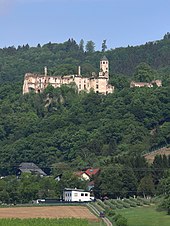Hohenegg Castle (Lower Austria)
| Hohenegg Castle | ||
|---|---|---|
|
Hohenegg castle ruins in January 2014 |
||
| Creation time : | First mentioned in 1140 | |
| Castle type : | Hilltop castle | |
| Conservation status: | ruin | |
| Place: | Hafnerbach | |
| Geographical location | 48 ° 14 '0.5 " N , 15 ° 28' 37.4" E | |
|
|
||
The Burg Hohenegg is the ruins of a hilltop castle in Dunkelsteinerwald in Hafnerbach in the district of Sankt Pölten-Land in Lower Austria . Until the abolition of the manorial rule in 1848, Hohenegg was the oldest and most important rule among all that belonged to the unified Mitterau rule .
history
The castle is first mentioned in a document in 1140. In 1173 the son of Hermann von Stein, Count Gebhart, named himself after Hohenegg Castle. After 1188 the castle came to a branch of the Counts of Hohenburg, who brought it into the marriage with Diepold Margrave of Vohburg. Around 1210 the castle was given to Rudolf von Pottendorf as a princely fief. Around 1358 Reinprecht I von Walsee acquired the castle from his brother-in-law Leutold von Pottendorf. The Lords of Walsee had major extensions made in 1463. Wolfgang V. von Walsee sold Hohenegg Castle in 1464 to Matthäus Spaur, who had carried out the extensions a year earlier. This was followed in 1513 by Sigmund and in 1534 by Christoph, Baron von Spaur, as lords of the castle.
In 1542 Christoph von Spaur sold the castle to Ludwig von Kirchberg. In 1571 they received his heirs.
In 1579 Albrecht, Baron von Enenkel, acquired the Hohenegg lordship and castle from the Kirchberg heirs and had it converted into a Renaissance palace between 1584 and 1594. The castle passed to the Mamming family in 1606.
In 1624, when Count Ernesto Montecuccoli was enfeoffed by Emperor Ferdinand II , the Hohenegg rulership came to the Montecuccoli , which still owns important goods in the region to this day (e.g. Mitterau Castle ). In 1631 Countess Barbara Montecuccoli resided at Hohenegg. Nine years later around 1740, Count Zeno Montecuccoli relocated the manor from Hohenegg Castle to the nearby Mitterau Castle due to financial reasons. Hohenegg Castle was no longer the seat of the Montecuccoli, but it was still part of their property. When the family moved, the Hohenegg estate became part of the Mitterau estate, as it had now become the new manor . Prince Raimund Montecuccoli had Hohenegg expanded again later and also built the outer bailey and the seven-storey bell tower.
A resistance group from the Markersdorf air base used the lonely area during the Second World War to establish a secret meeting place and camp.
The Hohenegg reign around 1837
In 1837, the Hohenegg lordship was the largest and oldest part of the unified Mitterau lordship of the Montecuccoli in Lower Austria. The following can be read about the area of Hohenegg in the representation of the Archduchy of Austria under the Ens :
“For many years, the Hohenegg rule has included the following villages: the village of Hohenegg, Hafnerbach with the parish, Pfaffing, Sassendorf, Zendorf, Windschnur, Stein, Eichberg, Oed, Hengstberg, Korning, Ober = and Unter = Graben, Doppl, Rannersdorf, Ritzersdorf and Wimpassing, who are now all united with Mitterau. "
See also
literature
- Franz Xaver Joseph Schweickhardt : Presentation of the Archduchy of Austria under the Ens 1837, Vol. 8, pp. 16-27
Web links
- Entry via Hohenegg to Burgen-Austria
- The Hohenegg castle ruins on the side of the Hafnerbach community
- Hohenegg castle ruins on the side of fortifications in Austria
Individual evidence
- ↑ Thomas Jorda: "Clear mission". In: Nobility obliges: a series from NÖN. Niederösterreichische Nachrichten, October 11, 2010, accessed on January 8, 2015 .


